汉服英语介绍
- 格式:ppt
- 大小:6.01 MB
- 文档页数:8
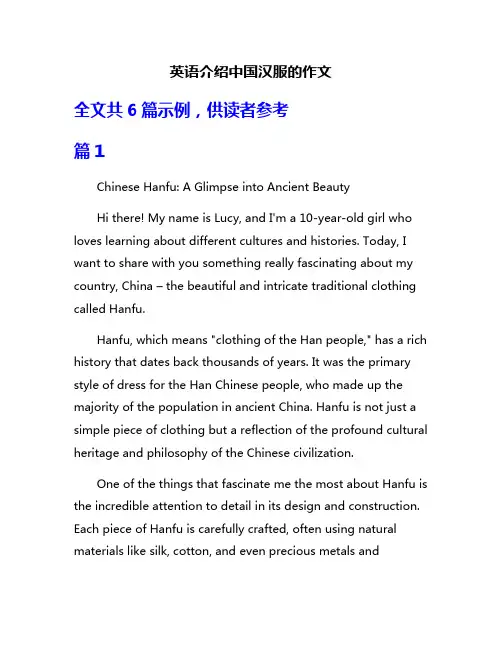
英语介绍中国汉服的作文全文共6篇示例,供读者参考篇1Chinese Hanfu: A Glimpse into Ancient BeautyHi there! My name is Lucy, and I'm a 10-year-old girl who loves learning about different cultures and histories. Today, I want to share with you something really fascinating about my country, China – the beautiful and intricate traditional clothing called Hanfu.Hanfu, which means "clothing of the Han people," has a rich history that dates back thousands of years. It was the primary style of dress for the Han Chinese people, who made up the majority of the population in ancient China. Hanfu is not just a simple piece of clothing but a reflection of the profound cultural heritage and philosophy of the Chinese civilization.One of the things that fascinate me the most about Hanfu is the incredible attention to detail in its design and construction. Each piece of Hanfu is carefully crafted, often using natural materials like silk, cotton, and even precious metals andgemstones for decoration. The intricate embroidery, intricate patterns, and vibrant colors make Hanfu truly a work of art.The styles of Hanfu vary greatly depending on the dynasty, region, and social status of the wearer. For example, the clothing worn by emperors and empresses was often adorned with elaborate designs and precious materials, symbolizing their power and wealth. On the other hand, the Hanfu worn by commoners was simpler but still elegant and practical.One of the most recognizable and iconic pieces of Hanfu is the long, flowing robe known as the "Qipao" or "Cheongsam." This form-fitting dress was popular during the Qing Dynasty and is still widely worn today, especially on special occasions like weddings and festivals. The Qipao is often made of silk and features intricate embroidery and patterns, such as dragons, phoenixes, and floral motifs, which hold deep cultural significance.Another fascinating aspect of Hanfu is the way it reflects the philosophical concepts of yin and yang, as well as the five elements (wood, fire, earth, metal, and water). The colors, patterns, and materials used in Hanfu were carefully chosen to represent these concepts and create a harmonious balance.For example, the color red is often associated with joy, prosperity, and good luck, while yellow represents royalty and power. The dragon motif is a symbol of strength and good fortune, while the phoenix represents grace, beauty, and virtue.Wearing Hanfu was not just about looking beautiful; it was also a way to express one's social status, values, and beliefs. The way a person dressed and carried themselves in Hanfu was a reflection of their character and personality.Nowadays, Hanfu is experiencing a renaissance, with many young people in China embracing this traditional clothing as a way to connect with their cultural roots and express their individuality. Hanfu enthusiasts often gather in parks and historical sites to showcase their beautiful outfits and share their love for this ancient art form.Personally, I find Hanfu fascinating because it represents the richness and diversity of Chinese culture. Every time I see someone wearing a beautifully crafted Hanfu, I feel a sense of pride and connection to my heritage. It's like stepping back in time and witnessing the grandeur and sophistication of ancient China.I hope that by sharing my love for Hanfu, I can inspire others to explore and appreciate the cultural treasures of differentcivilizations. After all, learning about different cultures is not only enriching but also helps us understand and respect one another's unique traditions and perspectives.So, the next time you see someone wearing a stunning Hanfu, take a moment to appreciate the intricate details, the vibrant colors, and the deep cultural symbolism behind this ancient Chinese attire. Who knows, you might just find yourself captivated by the enduring beauty and elegance of Hanfu, just like I have.篇2IntroductionHave you ever seen people in beautiful, colorful robes with elaborate designs? Those are hanfu, the traditional clothing of China. Hanfu has a long and fascinating history, with different styles for different occasions and social classes. Let me tell you all about this amazing part of Chinese culture!What is Hanfu?Hanfu literally means "clothing of the Han people." The Han were the major ethnic group in ancient China, so hanfu refers to the traditional dress of the Han Chinese over the centuries. Itoriginated over 3,000 years ago during the Shang Dynasty and evolved over time with changing materials, techniques, and styles influenced by different dynasties and regions.The Iconic StylesThere are many iconic hanfu styles, but some of the most famous are:The Shenyi - A long robe with long, flowing sleeves, worn by scholars and officials. It had a round neck and was crossed over at the front.The Aoqun - A robe with a wrap around skirt, worn by women. It had criss-cross collar pieces and was elaborately patterned.The Beiguan - A type of jacket and skirt set worn by unmarried women, usually in shades of green and red.The Changshan - A long, loose robe worn by both men and women. It had an upright collar and was well-suited for horseback riding.Colors and PatternsHanfu came in a dazzling array of colors and patterns. The colors used often symbolized different things - red for happiness,yellow for royalty, green for peace and nature. Patterns included things like clouds, dragons, phoenixes, flowers and geometric shapes. The more elaborate the style, the higher the social rank it represented.Rich with MeaningMore than just clothing, hanfu was steeped in meaning and tradition. Design elements like collars, buttons, colors, embroidery, and accessories all carried symbolic significance related to culture, status, and occasion. Wearing the proper hanfu at the right events was extremely important.The Phases of HanfuHanfu can be divided into a few key phases:Early Hanfu - Simple tunics and robes from ancient dynasties like the Shang, Zhou and Han. Made of silk and linen.Medieval Hanfu - More complex, layered styles from dynasties like the Tang and Song. Highly embroidered and patterned.Late Hanfu - Flowed from robes to more fitted styles in the Ming and Qing dynasties. Close-fitting jackets and trousers became popular.So you see, hanfu evolved tremendously over China's long history while retaining its essential elegance and cultural importance.The Decline and RevivalSadly, hanfu declined in the late 19th and early 20th centuries, replaced by Western-style clothing. Some people saw hanfu as old-fashioned and impractical for modern times. But in recent decades, there has been a huge revival and resurgence of interest in hanfu among the Chinese people.Hanfu enthusiasts now make and wear the clothing to celebrate Chinese cultural festivals, take photos, and even for everyday wear! They see hanfu as a beautiful connection to China's grand history and traditions. Learning traditional hanfu designs, colors, and embroidery techniques has become popular.My Favorite HanfuIf I had to pick my favorite style, I think it would be the brightly-colored aoqun robe and skirt set that ancient Chinese noblewomen wore. All the rich embroidery and patterns look so intricate and magnificent! And I especially love the cloud and phoenix designs. I can imagine how the luxurious silk must have swished elegantly as they walked.Hanfu is such a special and meaningful part of Chinese heritage. Not only are the designs exquisite, but they connect the wearer to thousands of years of ancestors and culture. Seeing people wear hanfu today reminds me of China's long, proud history and gives me a sense of wonder about the past. I hope more people will take an interest in reviving and preserving this beautiful tradition.篇3Certainly! Here is an essay about Hanfu, the traditional Chinese clothing, written in English from the perspective of an elementary school student. The length is around 2,000 words.Hanfu: The Beautiful Traditional Clothes of ChinaHello, my name is Lily, and I'm a 10-year-old girl from Beijing, China. Today, I want to tell you about something that I'm really excited about – Hanfu, the traditional Chinese clothing!Have you ever seen people wearing those beautiful, colorful robes with intricate designs? That's Hanfu! It's not like the modern Chinese clothes you might be familiar with. Hanfu has been around for thousands of years, and it has a rich history and cultural significance.Back in the old days, Hanfu was worn by everyone in China, from the emperors and nobles to the common people. It was a way of expressing one's social status, occupation, and even marital status. The designs, colors, and styles of Hanfu varied greatly depending on these factors.Let me tell you about the different parts of Hanfu and what they mean.First, there's the robe or gown, which is the main part of the outfit. For men, it's called a Pao, and for women, it's called a Qun or Gunfu. These robes come in all sorts of colors and patterns, each with its own symbolic meaning. For example, yellow was a color reserved for the emperor, while red symbolized happiness and good luck.Then, there are the accessories that go with Hanfu. One of the most important ones is the belt, called a Dai. It's not just for holding the robe together; the way it's tied and the materials used also have special meanings. For instance, a jade belt was worn by high-ranking officials.Another essential accessory is the shoes. Traditional Chinese shoes are called Huaxue, and they have a unique design with a curved toe and a flat sole. They're often embroidered withintricate patterns and come in various colors and materials, such as silk or satin.And let's not forget about the headwear! Men typically wore hats or caps called Guan or Mao, while women wore various styles of hairpieces and ornaments called Ji or Chai. These headpieces were not only decorative but also indicated the wearer's social status and marital status.Now, you might be wondering, "Why is Hanfu so important?" Well, it's not just about the clothing itself; it represents the rich cultural heritage of China. Each design, color, and accessory has a deeper meaning rooted in Chinese philosophy, history, and traditions.For example, many of the patterns and symbols used in Hanfu are inspired by nature, such as clouds, dragons, phoenixes, and flowers. These elements represent harmony, balance, and the cycle of life, which are important concepts in Chinese culture.Hanfu also reflects the values and ideals of Confucianism, an influential philosophy that has shaped Chinese society for centuries. The emphasis on propriety, hierarchy, and social order is reflected in the intricate designs and strict rules surrounding the wearing of Hanfu.In recent years, there has been a growing movement to revive and promote Hanfu in China. Many people, especially the younger generation, have become interested in learning about and wearing Hanfu as a way to connect with their cultural roots and express their love for traditional Chinese culture.There are now Hanfu clubs, festivals, and even fashion shows dedicated to showcasing the beauty and diversity of these traditional garments. It's amazing to see people of all ages proudly wearing Hanfu and celebrating the rich heritage behind it.Personally, I think Hanfu is absolutely gorgeous! I love the vibrant colors, the intricate patterns, and the way each piece tells a story. Whenever I see someone wearing Hanfu, I feel a sense of pride and connection to my cultural heritage.I hope that by learning about Hanfu, you've gained a deeper appreciation for the rich cultural traditions of China. Traditional clothing is not just about fashion; it's a reflection of a nation's history, values, and identity.Who knows, maybe one day you'll have the chance to try on a beautiful Hanfu robe or attend a Hanfu festival! It's an experience that will truly transport you back in time and allowyou to connect with the ancient wisdom and beauty of Chinese culture.篇4Traditional Chinese Clothing: The Beauty of HanfuHave you ever seen people wearing beautiful, flowing robes with intricate designs? Those amazing outfits are called Hanfu, which means "clothing of the Han people." Hanfu is the traditional clothing of China, and it has a long, fascinating history dating back thousands of years!Hanfu has been around since ancient times, and it's deeply connected to Chinese culture. In the past, what you wore showed your social status, occupation, and even your age. The fancier the clothing, the higher your rank in society. Isn't that interesting?The earliest Hanfu styles were quite simple, with loose robes and not many decorations. But as time went on, Hanfu became more and more elaborate, with gorgeous embroidery, beautiful colors, and fancy accessories like jade ornaments and hairpins.One of the most iconic Hanfu styles is the cross-collar robe, which has a unique crossed collar design. This style was popular during the Tang Dynasty, which lasted from 618 to 907 AD. TheTang Dynasty was a golden age for Chinese culture, and its Hanfu designs were incredibly intricate and eye-catching.Another famous Hanfu style is the horse-face skirt, which originated during the Ming Dynasty (1368-1644). It got its name because the wide, flared skirt reminded people of a horse's face! Can you imagine wearing a skirt that looks like a horse's face? It must have been quite a sight!Hanfu wasn't just about looking pretty, though. The clothing was also designed to be practical and comfortable. Many Hanfu robes had loose sleeves and flowy skirts, which allowed for easy movement. The materials used, like silk and cotton, were breathable and perfect for China's warm climate.Making Hanfu was a true art form. Skilled artisans would spend months carefully weaving the fabrics, embroidering intricate patterns, and sewing the garments together. Some of the most exquisite Hanfu pieces were reserved for the imperial family and high-ranking officials.Sadly, Hanfu fell out of fashion during the last imperial dynasty, the Qing Dynasty (1644-1912). People started wearing more Western-style clothing, and Hanfu became less common. But in recent years, there has been a fantastic revival of interest in this traditional Chinese clothing!Many people in China, and even around the world, are rediscovering the beauty of Hanfu and wearing it for special occasions or just for fun. Hanfu enthusiasts love the rich history, vibrant colors, and elegant designs of these traditional garments.Some people even make their own Hanfu at home, carefully following ancient patterns and techniques. It's a way to connect with China's cultural heritage and keep this amazing tradition alive.Wearing Hanfu is like stepping back in time and experiencing the grandeur of ancient Chinese civilization. From the intricate embroidery to the flowing silhouettes, every detail of Hanfu tells a story about China's fascinating past.So, the next time you see someone wearing a stunning Hanfu outfit, you'll know all about the incredible history and craftsmanship behind it. Hanfu is more than just clothing – it's a living link to China's rich cultural treasures, and a testament to the creativity and skill of its people throughout the ages.篇5Chinese Traditional Clothing: The Beauty of HanfuHi there! My name is Xiaoming and I'm a 10-year-old student from Beijing. Today, I want to share with you about the beautiful traditional clothing of China called Hanfu. It's something I find really fascinating and I hope you'll enjoy learning about it too!Hanfu refers to the traditional dress of the Han Chinese people. It has a long history going back thousands of years. Different styles emerged during various dynasties, but they all share some common features that make Hanfu so special.One of the most striking things about Hanfu is the bright, vibrant colors used. Hanfu outfits often feature rich shades of red, yellow, blue, green and more. The colors are said to represent the five elements of nature - fire, earth, wood, metal and water. I think using so many vivid hues makes the clothing look absolutely gorgeous!The fabrics used for Hanfu are also very special. High-quality materials like silk, cotton and linen were commonly used. Skilled artisans would carefully weave intricate patterns and designs into the fabrics. Some of the most valuable Hanfu featured incredibly detailed embroidery using gold and silver threads. Just imagine how shimmery and luxurious those pieces looked!Hanfu has a unique cross-collared design that makes it easy to recognize. For women, the most iconic style is a long, flowing robe called a gunfu. It has loose crossed collars and wide sleeves. For men, there are robes with a similar cross-collar style, but also jackets and coats. Many of the designs allow for easy layering of the different garments.Another thing I really admire about Hanfu is how the clothing was styled. Women often wore their hair elaborately arranged, accessorized with ornate hairpins, combs, and other beautiful pieces. Hanfu outfits were frequently paired with various kinds of jewelry like rings, bracelets, necklaces and more. The overall effect was one of grandness and elegance.In ancient times, the specific styles of Hanfu someone wore depended on their social rank and status. The elite members of society like emperors, nobles and scholars had access to the most ornate and luxurious Hanfu. Meanwhile, common people tended to wear simpler, more subdued versions. However, even the ordinary Hanfu reflected craftsmanship and cultural meaning.These days, Hanfu is seen more as a cultural symbol than daily wear. However, there has been a revival of interest in Hanfu, with many people in China studying and recreating the ancientstyles. Hanfu is commonly worn during cultural events, festivals, photography sessions and the like. Some people even choose to wear modernized versions of Hanfu for formal occasions like weddings!What I find most special about Hanfu is how it connects us to our rich history and cultural heritage as Chinese people. When I see the intricate embroidery, thoughtful color combinations and graceful designs, I feel a sense of pride. Hanfu is not just beautiful clothing - it is wearable art that reflects the values, beliefs and aesthetics of ancient Chinese civilization.I encourage you all to look up pictures and videos about Hanfu online. I'm sure you'll be just as amazed as I am by the incredible detail and splendor of this traditional dress. Let's work together to ensure this precious element of our culture is appreciated for generations to come!篇6Chinese Hanfu: A Colorful Journey Through HistoryHi, my name is Emily, and I'm a 10-year-old girl who loves learning about different cultures and traditions. Today, I want to share with you something fascinating about China – the beautiful and intricate traditional clothing called Hanfu.Hanfu has a long and rich history that dates back thousands of years. It's like a colorful tapestry woven with stories and meanings that have been passed down from generation to generation. Just imagine, these gorgeous garments were worn by emperors, nobles, and everyday people in ancient China!One of the things I find most amazing about Hanfu is the incredible variety of styles and designs. There are different types of Hanfu for different occasions, like formal court wear, everyday casual wear, and even special outfits for weddings and celebrations. Each style has its own unique features, colors, and patterns that tell a story about the wearer's social status, region, or cultural background.For example, the Qixiong Ruqun is a type of Hanfu worn by noblewomen during the Tang Dynasty. It's a stunning ensemble with a long, flowing robe and a beautiful embroidered jacket called a Banbi. The colors and patterns used in the embroidery often had special meanings, like peony flowers representing wealth and prosperity, or dragons symbolizing power and strength.Another fascinating style is the Beizi, a type of Hanfu worn by scholars and officials during the Ming and Qing Dynasties. It features a long, loose robe with wide sleeves and a uniquehorseshoe-shaped collar called a Lingdai. The Beizi was often made from silk or satin and adorned with intricate embroidery or painted designs depicting beautiful landscapes or philosophical sayings.But Hanfu isn't just about fancy robes and lavish embroidery. Even the simpler, everyday styles have their own charm and cultural significance. For instance, the Zhiduo was a type of casual Hanfu worn by commoners during the Han Dynasty. It consisted of a long, loose jacket called a Shangyi and a skirt or pants called a Kuitou. The beauty of the Zhiduo lies in its simplicity and practicality, making it perfect for daily activities like farming or running errands.One of my favorite things about Hanfu is the way it celebrates the beauty of nature and the changing seasons. Many Hanfu designs incorporate floral patterns, like the delicate cherry blossoms that symbolize the arrival of spring or the vibrant peonies that represent summer's radiance. Even the colors used in Hanfu often reflect the hues of nature, from the deep greens of lush forests to the rich reds and oranges of autumn leaves.Wearing Hanfu isn't just about looking beautiful; it's also a way to connect with China's rich cultural heritage and history. Each piece tells a story about the lives and traditions of peoplewho lived centuries ago. It's like stepping into a time machine and experiencing a glimpse of ancient China's splendor and sophistication.Nowadays, Hanfu is making a comeback, and many people in China and around the world are rediscovering the joy of wearing these traditional garments. There are even Hanfu enthusiasts who gather for special events, like cultural festivals or photography sessions, to showcase their beautiful outfits and share their love for this ancient art form.I find it truly fascinating how something as simple as clothing can hold so much meaning and history. Hanfu is a vibrant tapestry that weaves together the threads of China's past, present, and future. It's a testament to the creativity, craftsmanship, and cultural richness of a civilization that has endured for thousands of years.As a young student, learning about Hanfu has sparked my curiosity and appreciation for different cultures and traditions. It reminds me that there's so much beauty and wisdom to be found in the world around us, if we take the time to explore and learn about it.So the next time you see someone wearing a stunning Hanfu outfit, remember that it's not just a pretty dress or robe – it's aliving embodiment of China's incredible history and cultural heritage. Each stitch, each color, and each pattern holds a story waiting to be discovered and appreciated.。
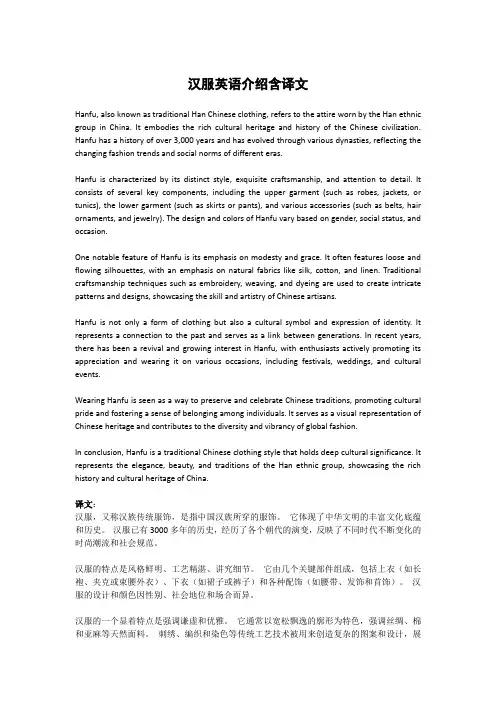
汉服英语介绍含译文Hanfu, also known as traditional Han Chinese clothing, refers to the attire worn by the Han ethnic group in China. It embodies the rich cultural heritage and history of the Chinese civilization. Hanfu has a history of over 3,000 years and has evolved through various dynasties, reflecting the changing fashion trends and social norms of different eras.Hanfu is characterized by its distinct style, exquisite craftsmanship, and attention to detail. It consists of several key components, including the upper garment (such as robes, jackets, or tunics), the lower garment (such as skirts or pants), and various accessories (such as belts, hair ornaments, and jewelry). The design and colors of Hanfu vary based on gender, social status, and occasion.One notable feature of Hanfu is its emphasis on modesty and grace. It often features loose and flowing silhouettes, with an emphasis on natural fabrics like silk, cotton, and linen. Traditional craftsmanship techniques such as embroidery, weaving, and dyeing are used to create intricate patterns and designs, showcasing the skill and artistry of Chinese artisans.Hanfu is not only a form of clothing but also a cultural symbol and expression of identity. It represents a connection to the past and serves as a link between generations. In recent years, there has been a revival and growing interest in Hanfu, with enthusiasts actively promoting its appreciation and wearing it on various occasions, including festivals, weddings, and cultural events.Wearing Hanfu is seen as a way to preserve and celebrate Chinese traditions, promoting cultural pride and fostering a sense of belonging among individuals. It serves as a visual representation of Chinese heritage and contributes to the diversity and vibrancy of global fashion.In conclusion, Hanfu is a traditional Chinese clothing style that holds deep cultural significance. It represents the elegance, beauty, and traditions of the Han ethnic group, showcasing the rich history and cultural heritage of China.译文:汉服,又称汉族传统服饰,是指中国汉族所穿的服饰。
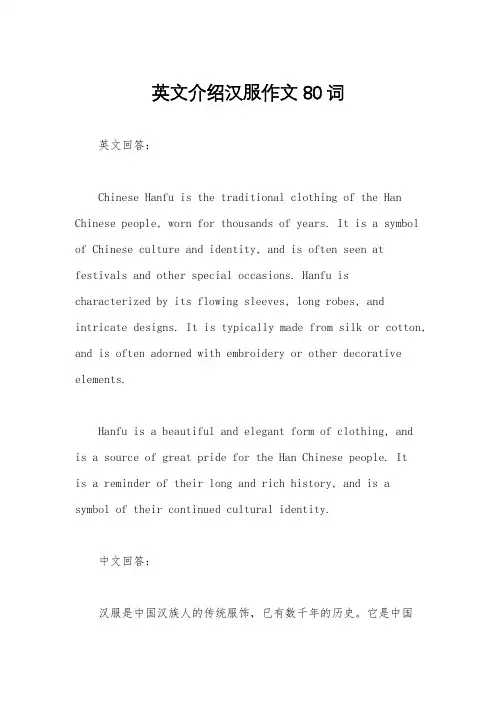
英文介绍汉服作文80词英文回答:Chinese Hanfu is the traditional clothing of the Han Chinese people, worn for thousands of years. It is a symbol of Chinese culture and identity, and is often seen at festivals and other special occasions. Hanfu is characterized by its flowing sleeves, long robes, and intricate designs. It is typically made from silk or cotton, and is often adorned with embroidery or other decorative elements.Hanfu is a beautiful and elegant form of clothing, andis a source of great pride for the Han Chinese people. Itis a reminder of their long and rich history, and is a symbol of their continued cultural identity.中文回答:汉服是中国汉族人的传统服饰,已有数千年的历史。
它是中国文化和身份的象征,经常在节日和其他特殊场合见到。
汉服的特点是宽大的袖子、长袍和精美的设计。
它通常由丝绸或棉花制成,并经常饰有刺绣或其他装饰元素。
汉服是一种美丽而优雅的服装形式,是汉族人的骄傲。
它提醒着他们悠久而丰富的历史,象征着他们延续不断的文化认同。
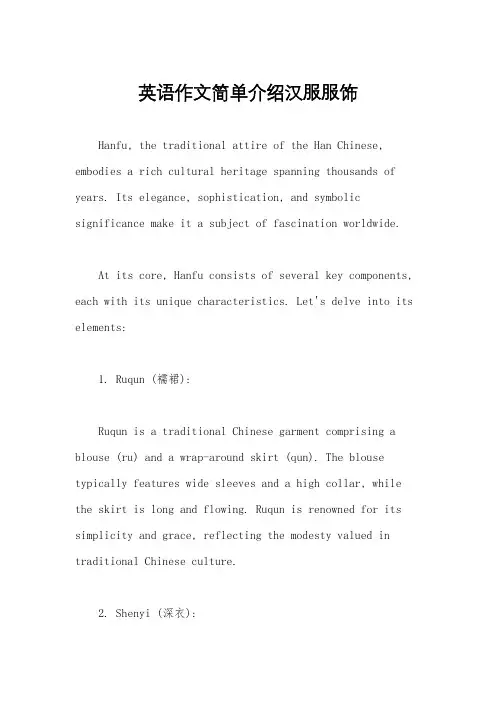
英语作文简单介绍汉服服饰Hanfu, the traditional attire of the Han Chinese, embodies a rich cultural heritage spanning thousands of years. Its elegance, sophistication, and symbolic significance make it a subject of fascination worldwide.At its core, Hanfu consists of several key components, each with its unique characteristics. Let's delve into its elements:1. Ruqun (襦裙):Ruqun is a traditional Chinese garment comprising a blouse (ru) and a wrap-around skirt (qun). The blouse typically features wide sleeves and a high collar, while the skirt is long and flowing. Ruqun is renowned for its simplicity and grace, reflecting the modesty valued in traditional Chinese culture.2. Shenyi (深衣):Shenyi is an ancient form of Han Chinese clothing that originated in the Shang Dynasty (c. 1600–1046 BCE). It consists of a cross-collar robe (yi) worn over a pleated skirt. Shenyi symbolizes the hierarchical structure of ancient Chinese society, with different variations worn by individuals of various social statuses.3. Zhongshan Zhuang (中山装):Zhongshan Zhuang, also known as the Zhongshan suit, is a modern adaptation of traditional Chinese attire. It features a high-collared, long-sleeved jacket paired with trousers, reflecting the influence of Western fashion during the early 20th century. Zhongshan Zhuang is often worn on formal occasions and has become a symbol of Chinese national identity.4. Quju (曲裾):Quju is a style of Han Chinese clothing characterized by its asymmetrical hemline, which forms a flowing curveknown as "water sleeve." This design element adds a senseof movement and dynamism to the garment, making it particularly suitable for ceremonial occasions such as weddings and festivals.5. Pibo (披帛):Pibo refers to the outer garments worn over the primary attire, such as robes, coats, and cloaks. These garmentsare often made from luxurious fabrics such as silk and satin, adorned with intricate embroidery and decorative patterns. Pibo not only provides warmth and protection but also serves as a means of expressing one's social statusand aesthetic taste.In addition to these main components, Hanfu may also include various accessories such as hair ornaments, jewelry, and footwear, each playing a role in completing the overall ensemble and adding personal flair.Overall, Hanfu represents more than just a form of dress; it encapsulates the essence of Chinese culture,embodying tradition, history, and artistic expression. As interest in Hanfu continues to grow both domestically and internationally, it serves as a bridge connecting the past with the present, preserving and celebrating China's rich cultural heritage for generations to come.。
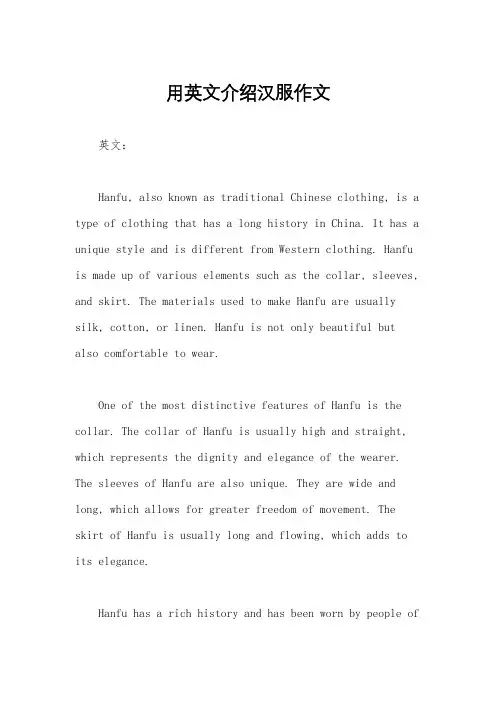
用英文介绍汉服作文英文:Hanfu, also known as traditional Chinese clothing, is a type of clothing that has a long history in China. It has a unique style and is different from Western clothing. Hanfu is made up of various elements such as the collar, sleeves, and skirt. The materials used to make Hanfu are usually silk, cotton, or linen. Hanfu is not only beautiful but also comfortable to wear.One of the most distinctive features of Hanfu is the collar. The collar of Hanfu is usually high and straight, which represents the dignity and elegance of the wearer. The sleeves of Hanfu are also unique. They are wide and long, which allows for greater freedom of movement. The skirt of Hanfu is usually long and flowing, which adds to its elegance.Hanfu has a rich history and has been worn by people ofdifferent social classes throughout the ages. In ancient times, Hanfu was worn by emperors, officials, and scholars. Today, Hanfu is worn by people who appreciate traditional Chinese culture and want to express their love for it.中文:汉服,也称传统中国服饰,是中国历史悠久的一种服饰。
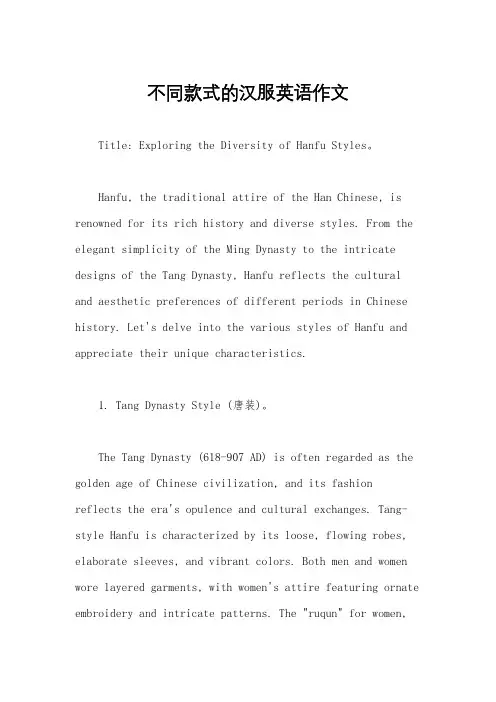
普通员工个人工作总结精编版我是____销售部门的一名普通员工,刚到房产时,该同志对房地产方面的知识不是很精通,对于新环境、新事物比较陌生。
在公司领导的帮助下,我很快了解到公司的性质及其房地产市场。
作为销售部中的一员,该同志深深觉到自己身肩重任。
作为企业的门面,企业的窗口,自己的一言一行也同时代表了一个企业的形象。
所以更要提高自身的素质,高标准的要求自己。
在高素质的基础上更要加强自己的专业知识和专业技能。
此外,还要广泛了解整个房地产市场的动态,走在市场的前沿。
经过这段时间的磨练,我已成为一名合格的销售人员,并且努力做好自己的本职工作。
____年下旬公司与____公司合作,这又是公司的一次重大变革和质的飞跃。
在此期间主要是针对房屋的销售。
经过之前销售部对房屋执行内部认购等手段的铺垫制造出____火爆场面。
在销售部,我担任销售内业及会计两种职务。
面对工作量的增加以及销售工作的系统化和正规化,工作显得繁重和其中。
在开盘之际,该同志基本上每天都要加班加点完成工作。
经过一个多月时间的熟悉和了解,我立刻进入角色并且娴熟的完成了自己的本职工作。
由于房款数额巨大,在收款的过程中该同志做到谨慎认真,现已收取了上千万的房款,每一笔帐目都相得益彰,无一差错。
此外在此销售过程中每月的工作总结和每周例会,该同志不断总结自己的工作经验,及时找出弊端并及早改善。
销售部在短短的三个月的时间将二期房屋全部清盘,而且一期余房也一并售罄,这其中与我和其他销售部成员的努力是分不开的。
____年这一年是有意义的、有价值的、有收获的。
公司在每一名员工的努力下,在新的一年中将会有新的突破,新的气象,能够在日益激烈的市场竞争中,占有一席之地。
普通员工个人工作总结精编版(二)记得刚进公司的那会,不明白自己该干什么,师父交代的活儿干完了就不明白干啥了,脑子一片空白。
每一天下线、压端子、分线,原先这就是工作。
心里很不是滋味,校园学的知识一点都不能学以致用,很迷茫。
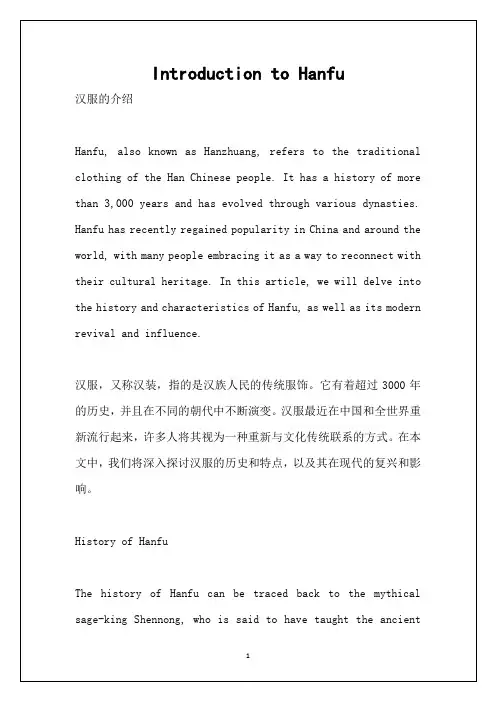
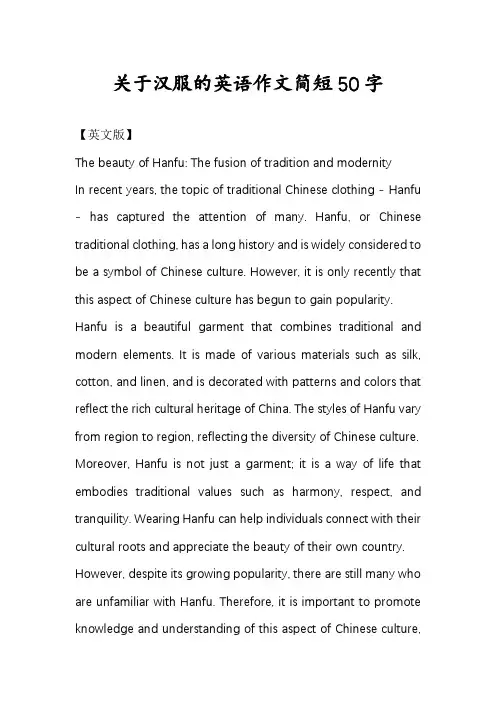
关于汉服的英语作文简短50字【英文版】The beauty of Hanfu: The fusion of tradition and modernityIn recent years, the topic of traditional Chinese clothing - Hanfu - has captured the attention of many. Hanfu, or Chinese traditional clothing, has a long history and is widely considered to be a symbol of Chinese culture. However, it is only recently that this aspect of Chinese culture has begun to gain popularity. Hanfu is a beautiful garment that combines traditional and modern elements. It is made of various materials such as silk, cotton, and linen, and is decorated with patterns and colors that reflect the rich cultural heritage of China. The styles of Hanfu vary from region to region, reflecting the diversity of Chinese culture. Moreover, Hanfu is not just a garment; it is a way of life that embodies traditional values such as harmony, respect, and tranquility. Wearing Hanfu can help individuals connect with their cultural roots and appreciate the beauty of their own country. However, despite its growing popularity, there are still many who are unfamiliar with Hanfu. Therefore, it is important to promote knowledge and understanding of this aspect of Chinese culture,so that it can be appreciated by a wider audience.【中文版】近年来,中国传统服饰——汉服的话题引起了众多关注。

高中介绍中国汉服的英语作文Chinese Hanfu, also known as traditional Chinese clothing, is a type of clothing that dates back to ancient times in China. It is characterized by its loose and flowing style, bright colors, intricate embroidery, and elegant design. Chinese Hanfu is not only a form of dress but also a symbol of Chinese culture and history.Chinese Hanfu is typically made from silk, cotton, or other high-quality fabrics. The designs vary depending on the time period and the social status of the wearer. There are different styles of Hanfu for men and women, as well as for different occasions such as formal events, casual wear, or ceremonial attire.One of the most famous styles of Hanfu is the Tang suit, which originated in the Tang Dynasty (618-907 AD). The Tang suit is characterized by its high collar, crossed collars, and straight-cut style. It is often worn for formal occasions and is considered a classic symbol of Chinese culture.In recent years, there has been a resurgence of interest in Chinese Hanfu, especially among young people in China. Many people are embracing Hanfu as a way to connect with their cultural roots and express their pride in Chinese heritage. There are now Hanfu clubs, events, and online communities dedicated to promoting and preserving this traditional form of dress.In conclusion, Chinese Hanfu is not just a type of clothing, but a symbol of Chinese culture, history, and identity. It is a beautiful and elegant form of dress that has stood the test of time and continues to be cherished by people around the world.中国汉服,也被称为中国传统服饰,可以追溯到中国古代。
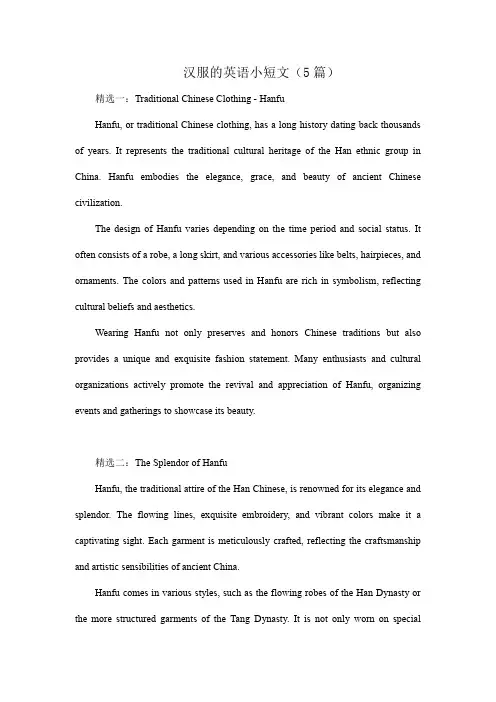
汉服的英语小短文(5篇)精选一:Traditional Chinese Clothing - HanfuHanfu, or traditional Chinese clothing, has a long history dating back thousands of years. It represents the traditional cultural heritage of the Han ethnic group in China. Hanfu embodies the elegance, grace, and beauty of ancient Chinese civilization.The design of Hanfu varies depending on the time period and social status. It often consists of a robe, a long skirt, and various accessories like belts, hairpieces, and ornaments. The colors and patterns used in Hanfu are rich in symbolism, reflecting cultural beliefs and aesthetics.Wearing Hanfu not only preserves and honors Chinese traditions but also provides a unique and exquisite fashion statement. Many enthusiasts and cultural organizations actively promote the revival and appreciation of Hanfu, organizing events and gatherings to showcase its beauty.精选二:The Splendor of HanfuHanfu, the traditional attire of the Han Chinese, is renowned for its elegance and splendor. The flowing lines, exquisite embroidery, and vibrant colors make it a captivating sight. Each garment is meticulously crafted, reflecting the craftsmanship and artistic sensibilities of ancient China.Hanfu comes in various styles, such as the flowing robes of the Han Dynasty or the more structured garments of the Tang Dynasty. It is not only worn on specialoccasions but also embraced by individuals as everyday attire, emphasizing the fusion of tradition and modernity.By wearing Hanfu, people not only connect with their cultural roots but also express their admiration for the timeless beauty and grace of traditional Chinese clothing. It is a way to appreciate the rich heritage of China and showcase its magnificence to the world.精选三:Hanfu and Cultural IdentityHanfu represents more than just clothing; it embodies the cultural identity and pride of the Han Chinese. It is a symbol of heritage and tradition, reminding people of their historical roots and the legacy passed down through generations.Through the revival and promotion of Hanfu, people seek to reconnect with their cultural heritage, fostering a sense of belonging and unity. It serves as a visual reminder of the profound history and contributions of the Han Chinese to Chinese civilization.Wearing Hanfu allows individuals to immerse themselves in the aesthetics and values of ancient China, showcasing the grace, modesty, and respect that were highly valued in traditional society. It is a way to preserve and celebrate the rich cultural diversity of China.精选四:Hanfu and Modern FashionIn recent years, Hanfu has gained popularity not only as a symbol of culturalheritage but also as a source of inspiration for modern fashion. Designers have incorporated elements of Hanfu into contemporary clothing, creating a fusion of traditional and modern styles.The beauty and elegance of Hanfu have captivated people worldwide, leading to its presence on international runways and in fashion magazines. This cross-cultural appreciation showcases the universal appeal of Hanfu and its ability to transcend time and boundaries.By integrating Hanfu into modern fashion, people are able to reinterpret and reinterpret traditional Chinese aesthetics, breathing new life into ancient traditions and bringing them into the contemporary world.精选五:Hanfu and Cultural ExchangeHanfu has become a medium for cultural exchange, promoting understanding and appreciation between different cultures. It serves as a bridge, connecting people from diverse backgrounds through a shared admiration for the beauty and cultural significance of traditional Chinese clothing.In international events and gatherings, individuals from various countries don Hanfu, immersing themselves in the elegance and charm of Chinese culture. This exchange not only fosters cultural appreciation but also promotes friendship and harmony among nations.Through the global popularity of Hanfu, traditional Chinese clothing has transcended national borders, becoming a symbol of cultural diversity and mutualrespect. It is a testament to the power of cultural exchange and the universal appeal of beauty and tradition.。
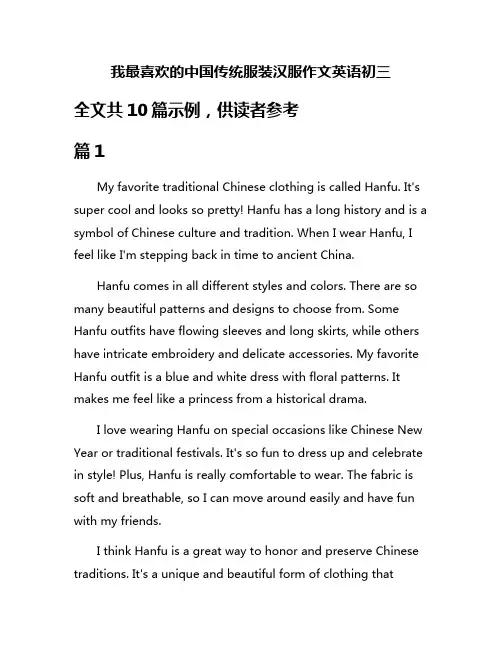
我最喜欢的中国传统服装汉服作文英语初三全文共10篇示例,供读者参考篇1My favorite traditional Chinese clothing is called Hanfu. It's super cool and looks so pretty! Hanfu has a long history and is a symbol of Chinese culture and tradition. When I wear Hanfu, I feel like I'm stepping back in time to ancient China.Hanfu comes in all different styles and colors. There are so many beautiful patterns and designs to choose from. Some Hanfu outfits have flowing sleeves and long skirts, while others have intricate embroidery and delicate accessories. My favorite Hanfu outfit is a blue and white dress with floral patterns. It makes me feel like a princess from a historical drama.I love wearing Hanfu on special occasions like Chinese New Year or traditional festivals. It's so fun to dress up and celebrate in style! Plus, Hanfu is really comfortable to wear. The fabric is soft and breathable, so I can move around easily and have fun with my friends.I think Hanfu is a great way to honor and preserve Chinese traditions. It's a unique and beautiful form of clothing thatshowcases the elegance and grace of Chinese culture. I hope more people will discover the beauty of Hanfu and learn to appreciate its history and significance. I will definitely continue to wear Hanfu and share my love for this amazing traditional clothing with others!篇2I'm going to tell you guys about my favorite Chinese traditional clothing called Hanfu. It's super cool and I love wearing it!Hanfu is a type of traditional Chinese clothing that dates back thousands of years. It's so beautiful and elegant, with flowing sleeves and delicate patterns. Whenever I put on my Hanfu, I feel like I'm stepping back in time to ancient China.One of the things I love most about Hanfu is the variety of styles and designs. There are so many different types of Hanfu to choose from, like the Ruqun, which is a two-piece outfit with a top and a skirt, or the Zhongshan suit, which is a more modern take on traditional clothing. I love trying out different styles and finding the one that suits me best.Another thing I love about Hanfu is the way it makes me feel. When I wear Hanfu, I feel proud and connected to my Chineseheritage. It's like wearing a piece of history and culture on my body, and it's a feeling that I can't get from any other type of clothing.Overall, Hanfu is my favorite Chinese traditional clothing because it's beautiful, elegant, and makes me feel proud of my heritage. I love wearing it and I can't wait to explore more styles and designs in the future!篇3My Favorite Traditional Chinese Clothing - HanfuHey guys! Today I wanna talk about my favorite traditional Chinese clothing - Hanfu. Hanfu is a kind of ancient Chinese clothing that I think is super cool and beautiful.First of all, Hanfu looks really elegant and graceful. It's usually made of silk, which is a very soft and smooth fabric. The colors of Hanfu are really pretty too, like red, blue, and green. There are also lots of lovely patterns and embroidery on Hanfu, which makes it even more special.Another thing I love about Hanfu is that it has a long history. It has been worn by Chinese people for thousands of years, so it's a symbol of our rich culture and traditions. When I see peoplewearing Hanfu, I feel like I'm back in ancient China, walking in the palace or attending a grand event.Besides, Hanfu is not only for special occasions. You can wear it in your daily life too, like going to a party or even just hanging out with friends. It makes you stand out and feel more connected to our traditional Chinese roots.In conclusion, Hanfu is my favorite traditional Chinese clothing because it's beautiful, elegant, and has a deep cultural significance. I hope more and more people will get to know and appreciate this amazing piece of our heritage. Let's all wear Hanfu and show off our love for Chinese culture!篇4My favorite Chinese traditional clothing is Hanfu. Hanfu is a beautiful and elegant dress that originated in ancient China. I love Hanfu because it makes me feel like a princess when I wear it.Hanfu is very different from modern clothing. It is made of silk or cotton and has flowing sleeves and a loose fit. The colors and patterns on Hanfu are also very exquisite, with delicate embroidery and intricate designs. When I put on Hanfu, I feel like I am stepping back in time to the ancient Chinese dynasties.One of the things I love most about Hanfu is the way it makes me feel when I wear it. I feel graceful and elegant, like a princess from a fairy tale. The flowing sleeves and long skirt swish around me as I walk, making me feel like I am floating on air. I also love the way Hanfu looks on me, with its beautiful colors and patterns that accentuate my features.Another reason why I love Hanfu is because it is a symbol of Chinese culture and heritage. Hanfu has a long history in China, dating back thousands of years. It is a reminder of the rich traditions and customs of the Chinese people, and wearing it makes me feel connected to my country's past.In conclusion, Hanfu is my favorite Chinese traditional clothing because it makes me feel like a princess, it is a symbol of Chinese culture, and it is simply beautiful. I love the way it looks and feels, and I will always cherish the moments when I get to wear it. Hanfu will always have a special place in my heart.篇5My Favorite Chinese Traditional Outfit - The HanfuHey everyone, today I want to talk about my favorite Chinese traditional outfit, the Hanfu. I think the Hanfu is super cool and really pretty. It's like a dress that people used to wear in ancientChina. It has beautiful patterns and colors, and it looks so elegant and graceful.I first learned about the Hanfu when I watched a historical drama on TV. The actors and actresses were wearing these amazing outfits, and I was so impressed. I wanted to learn more about the Hanfu, so I did some research online. I found out that the Hanfu has a long history, dating back to thousands of years ago. It was worn by people in the Han dynasty, which is how it got its name.One of the things I love most about the Hanfu is that it comes in different styles and designs. There are long robes, short jackets, and colorful skirts. Each piece of clothing is made with great attention to detail and craftsmanship. I think that's what makes the Hanfu so special.I also like how the Hanfu is not just a piece of clothing, but a symbol of Chinese culture and traditions. It represents the beauty and grace of ancient China, and wearing it makes me feel connected to my heritage.Overall, the Hanfu is my favorite Chinese traditional outfit because it's beautiful, elegant, and full of history. I hope one day I can wear a Hanfu myself and experience the magic of ancient China.篇6My favorite Chinese traditional outfit is the Hanfu. It's super cool and looks really elegant!Hanfu has been worn in China for like, thousands of years. It has all these different styles and designs, and they all look so awesome. I love how the sleeves are long and flowy, and the colors are so pretty - like bright red, deep blue, and soft pink.When you wear Hanfu, you feel like a character from a historical drama. It makes me feel like I'm a princess in ancient China, walking around in a beautiful palace. I wish I could wear Hanfu every day!One time, I got to wear a Hanfu for a school play, and I felt so special. My friends all thought I looked like a real princess, and they couldn't stop complimenting me. It was such a great feeling!I also love how Hanfu is so comfortable to wear. The fabric is soft and smooth, and it feels really nice against my skin. I wish all my clothes were as comfy as a Hanfu!In conclusion, Hanfu is my favorite traditional Chinese outfit because it's beautiful, elegant, and makes me feel like a princess.I hope I can wear Hanfu again soon and show off how awesome it looks!篇7I really like Hanfu, which is my favorite traditional Chinese clothing. Hanfu is so cool and beautiful! It's like stepping back in time to ancient China.Hanfu comes in all different styles and colors. There are long flowing robes, embroidered jackets, and colorful silk skirts. The intricate designs and patterns are so amazing to look at. It makes me feel like a prince or princess from a historical drama.One of the things I love most about Hanfu is how comfortable it is to wear. The loose-fitting clothes allow me to move freely and easily. I can run, play, or even dance in my Hanfu without any restrictions. It's perfect for any occasion, whether it's a special event or just a regular day.Another reason why I love Hanfu is because of the rich history and cultural significance behind it. It represents the elegance and grace of ancient Chinese civilization. It makes me feel connected to my roots and proud of my heritage.I enjoy dressing up in Hanfu and pretending to be a character from ancient times. It's like playing dress-up, but with a touch of tradition and history. I feel like a part of something bigger and more meaningful when I wear Hanfu.In conclusion, Hanfu is not just a piece of clothing to me. It's a symbol of my love for Chinese culture and history. It's a way for me to express myself and honor my ancestors. I will always cherish and admire Hanfu for its beauty, comfort, and cultural significance. I hope to continue wearing it and sharing its beauty with others.篇8Hanfu is my favorite traditional Chinese clothing. It is super cool! I love the colorful designs and the graceful style of Hanfu. Whenever I see people wearing Hanfu, I feel like I have traveled back in time to ancient China.Hanfu is not just a piece of clothing, it is a symbol of Chinese culture and history. The beautiful patterns and intricate details on Hanfu reflect the artistic talents of the ancient Chinese people.I love how each piece of Hanfu tells a story and represents a different dynasty.One of my favorite things about Hanfu is the variety of styles and colors. There are so many different types of Hanfu to choose from, each with its own unique charm. Whether it's a flowing robe or a colorful dress, Hanfu always makes me feel like a prince or princess from a bygone era.I also love how comfortable and elegant Hanfu is to wear. The soft, flowing fabrics and loose fitting designs make it easy to move around and feel free. Whenever I put on my Hanfu, I feel like I am part of a grand historical event, like a royal banquet or a traditional festival.In conclusion, Hanfu is not just a piece of clothing, it is a treasure trove of Chinese culture and history. I love everything about Hanfu, from its intricate designs to its graceful style. It is truly a magnificent symbol of China's rich heritage, and I feel proud to wear it. Hanfu forever!篇9My favorite traditional Chinese clothing is the Hanfu! Hanfu is a type of clothing worn by the Han ethnic group in ancient China. It is so beautiful and elegant, with flowing sleeves and intricate embroidery.I love Hanfu because it makes me feel like a graceful princess from ancient times. The soft, silky fabrics and vibrant colors make me feel so special when I wear it. I especially love the long, flowing skirts and the delicate patterns that adorn the sleeves and hems.One of my favorite Hanfu styles is the Ruqun, which consists of a top and a skirt that are layered on top of each other. It is so comfortable to wear and allows for freedom of movement, which is perfect for playing and dancing.I also love the traditional hair accessories that come with Hanfu, such as the hairpins and headpieces. They add a touch of elegance and sophistication to the overall look.Whenever I wear Hanfu, I feel like I am a part of history, connecting with the ancient traditions and customs of China. It gives me a sense of pride and honor to wear such a beautiful and meaningful piece of clothing.In conclusion, Hanfu is not just a type of clothing for me, it is a symbol of my cultural heritage and a way for me to express myself in a unique and beautiful way. I will continue to cherish and wear Hanfu with pride and joy for years to come.篇10My Favorite Traditional Chinese Clothing - HanfuHello everyone, today I want to talk about my favorite traditional Chinese clothing, which is called Hanfu. Hanfu is a beautiful and elegant outfit that has been worn by the Chinese people for thousands of years. It has colorful patterns and flowing designs that make it stand out from other types of clothing.I love Hanfu because it has a unique and rich history. It represents the traditional culture and values of China, and it is a symbol of the country's long and proud history. When I wear Hanfu, I feel like I am connecting to my roots and honoring the traditions of my ancestors.Another reason why I love Hanfu is because it is so comfortable to wear. The fabric is soft and breathable, and the loose-fitting design allows for easy movement. Whether I am walking, dancing, or just sitting down, I always feel comfortable and at ease in my Hanfu.In addition, Hanfu is incredibly beautiful. The intricate embroidery, delicate silk fabrics, and vibrant colors make it a feast for the eyes. Whenever I wear Hanfu, I feel like a princess from ancient China, and I can't help but admire myself in the mirror.Overall, Hanfu is a timeless and elegant piece of clothing that I am proud to wear. It reminds me of the rich history and culture of China, and it makes me feel connected to my heritage.I hope to continue wearing Hanfu and preserving this beautiful tradition for many years to come. Thank you for listening to my love for Hanfu!。
汉服分类及介绍英文作文英文:Hanfu is a traditional Chinese clothing that has a long history dating back to the Han Dynasty (206 BC-220 AD). It is characterized by its unique design and exquisite craftsmanship, and it has been widely loved by the Chinese people for generations. There are various types of Hanfu, each with its own distinctive features and styles.The first type of Hanfu is the Zhongshan suit, which is a modern version of the traditional Hanfu. It was introduced by Sun Yat-sen, the founder of the Republic of China, and it has become a popular formal attire for men in China. The suit consists of a jacket, a pair of trousers, and a white shirt, and it is usually worn with a tie.The second type of Hanfu is the Ruqun, which is a two-piece dress consisting of a blouse and a skirt. It is one of the most popular types of Hanfu and is commonly worn bywomen. The blouse is usually decorated with intricate embroidery and the skirt is long and flowing.The third type of Hanfu is the Beizi, which is a long robe that is worn over a shirt and trousers. It is usually made of silk or cotton and is decorated with patterns and designs. The Beizi was commonly worn by scholars andofficials during the Ming and Qing dynasties.In addition to these three types of Hanfu, there are many other types, such as the Shenyi, the Daxiushan, andthe Banbi. Each type has its own unique features and styles.中文:汉服是一种有着悠久历史的传统中国服饰,起源于汉朝(公元前206年-公元220年)。
介绍汉服的英语作文_Introduce Hanfu 4篇导读:关于”介绍汉服“的英语作文模板4篇,作文题目:Introduce Hanfu。
以下是关于介绍汉服的小学英语模板,每篇作文均为万能模板带翻译。
关于”介绍汉服“的英语作文模板4篇,作文题目:Introduce Hanfu。
以下是关于介绍汉服的小学英语模板,每篇作文均为万能模板带翻译。
高分英语作文1:Introduce HanfuXuanduan is a dress made to order in Zhou Dynasty. It is dark black and has wide sleeves. It is only used in large-scale activities, such as sacrificial opera Costume: one piece fashion dress with one or several rings around the body, forming a unique style.During the Warring States period, it was cost-effective as a market dress, while in the Han Dynasty, it was regarded as a formal dress. Because some of its narrow lapels did not spread to later generations, it was often mistaken for the kimono Shenyi (long skirt): in the Warring States period, the clothing was worn by both men and women (different from the popular upper and lower garments, which were composed of cloth pieces), which symbolized that there were several months in a year, and there was no fashion at that time It was passed down, but it was made into men's formal straight dress (straight dress) in the Ming Dynasty: through cutting men's clothes, fastening them with a belt or corset collar, and using a piece of cloth to form a lower garment, in the Ming Dynasty, it was usually made into a men's dress of togaz clergy,which was cut and made into a style of pendulum skirt with dark knees: Women's dress, such as a Katy Sark, while a group was a skirt Half sleeve women's upper garment, with sleeves similar to the current short sleeve open-ended skirt of Tang Dynasty style, similar to the general Ruqun, but tied on the chest, with Kezi and Chinese style jacket, Hanfefers to its style, front open collar jacket: Women's jacket of Tang Dynasty, not the common cross collar of Han Dynasty, but the open-ended horse face group not popular after the Tang Dynasty: a skirt of Ming Dynasty, with It has a rather gorgeous pendulum style: a cloak, as men's and women's clothes, Duanda (short clothes): the casual clothes of the working people, Chinese jacket and trousers, the jacket has a slit on both sides, and the sleeves are narrow, which is very convenient for labor. It can be used as casual clothes and household underwear: men wear underpants and pants, women wear underpants, and men must wear Zhongdan, and wear a white robe on their underwear.When people wear clothes, Han clothes without underwear are considered impolite, just as people wear suits without shirts.中文翻译:玄端为周代定做的礼服深黑色,袖子很宽,只在大型活动中使用,如祭品曲剧服:一件式的时装,在身体周围戴一个或几个环子,形成独特的风格。
汉服介绍英文作文素材英文,Introduction to Hanfu。
Hanfu is the traditional clothing of the Han Chinese people, which has a history of over 3,000 years. It is characterized by its unique style, exquisite craftsmanship, and rich cultural connotations. Hanfu has different styles for different occasions, such as daily wear, formal wear, and ceremonial wear.中文,汉服介绍。
汉服是汉族人民的传统服饰,历史悠久,有超过三千年的历史。
它以其独特的风格、精湛的工艺和丰富的文化内涵而著称。
汉服有不同的款式适用于不同的场合,如日常穿着、正式场合和仪式场合。
英文,Styles of Hanfu。
There are many styles of Hanfu, each with its ownunique characteristics. For example, the Ruqun styleconsists of a blouse and a long skirt, and is suitable for daily wear. The Zhiduo style, which has a long gown with wide sleeves and a skirt, is more formal and is often worn for important occasions such as weddings. The Shenyi style, which has a cross-collar and a long gown, is often used for ceremonial occasions.中文,汉服的款式。